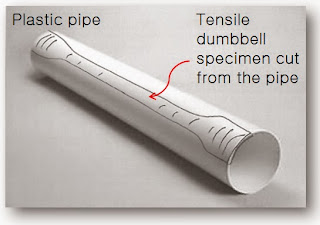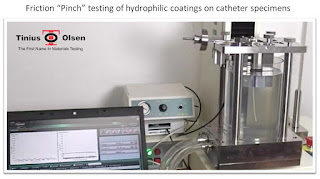Laser Extensometer Technology
At Tinius Olsen we have a range of extensometer technologies,
LVDT, strain gauge, encoder, video and laser. Each technology base has its
strength and weaknesses hence the range and is selected because of its performance
for a particular application, material to be tested and users ROI. A laser
extensometer such as the Tinius 500L uses a helium neon class two laser, which
means it’s very safe for use in a lab and does not require any special safety precautions.
The natural blinking of the eye provides protection although we don’t recommend
you look directly at the laser, frankly there is no need and it would not be easy
when configured with a Tinius materials testing machine.
The 500L scans the test specimen 320 times per second and
automatically measures the “Gauge length – L0” it does this by capturing the
reflection from two reflective marks placed on the test specimen, the leading
lower edge of which is actually captured (not the whole width of the tape mark).
As the sample is stretched by the tensile test the differential movement
between the marks is instantaneously captured and reported as strain %.
The 500L has a resolution of 12µm which means being a non-contacting
technology it is ideally suited for high strain materials such as elastomers (rubber
and the like) which may have a violent break and could therefore damage a contacting
type of extensometer and or where the specimen is required to be tested at cold
or elevated temperatures in a chamber. The laser light can pass through chamber
door glass windows (even triple glazed) similarly the reflected light takes the
same return path thus zero distortion.
The Tinius Olsen system uses heat resistant reflective tape
which sticks to the specimen yet does not cause interference with the materials
performance and therefore the results for Stress and Strain. However occasionally
we come across materials where the reflective tape marks will not stick, such as
a latex rubber with an oil based release agent on it. The solution is two small
very light weight spring clips, we bond the reflective tape marks to the clips
(using heat resistant adhesive), the user simply attaches the clips to the test
specimen. The clips are reusable and can be produced with varying clip pressure
as required.
When used with a temperature chamber the 500L mounts conveniently
on the chamber door, so it is instantly ready for use. Configuration, set up and
gauge length measurement is automatic under the control of the Tinius Horizon
materials testing software.
See clip showing a test with the 500L extensometer beam of light focused on the test specimen.
Want to learn more or see a demonstration contact us.
Want to learn more or see a demonstration contact us.
An extensometer is a device used to accurately measure strain %, in a tensile mode, relative to the initial test specimen length as typically defined by two “gauge marks” located on the specimen, which in the case of a dumbbell shape are defined within the reduced section.







Comments